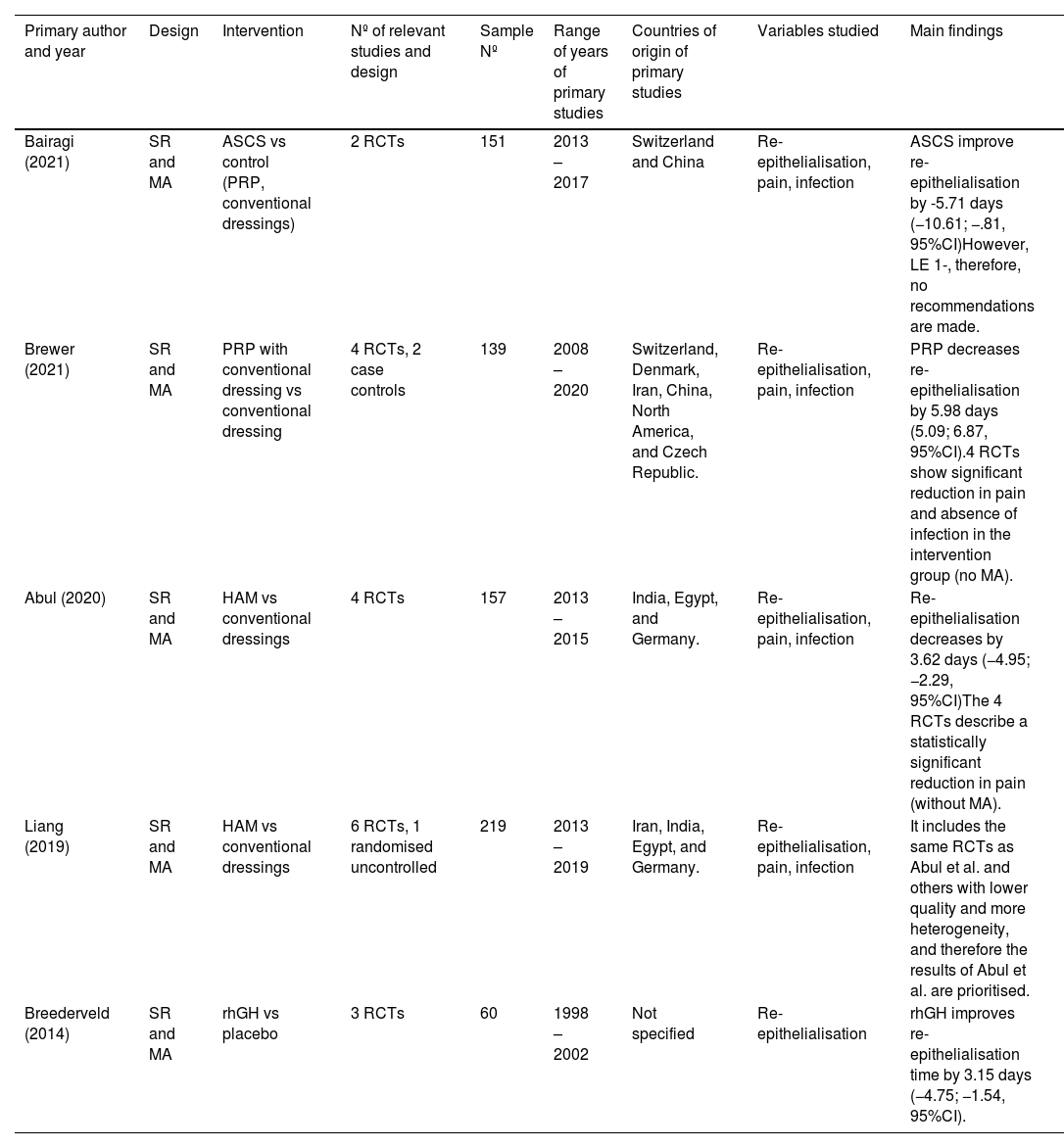To summarize the existing evidence and provide recommendations for the most effective management of partial-thickness graft donor sites in adults, with the goals of enhancing re-epithelialization, reducing pain, and preventing infection.
MethodologyUmbrella review. A systematic search was conducted encompassing databases such as Pubmed, CUIDEN, Cochrane Library, CINHAL Plus, SCOPUS, and LILACS. The search targeted systematic reviews published since 2011 that focused on examining the effectiveness of different approaches for the treatment of partial-thickness graft donor sites. Reviews with a low critical appraisal score according to AMSTAR 2 were excluded. The included reviews were evaluated using the SIGN scale to assess the level of evidence and grade the recommendations.
ResultsFive systematic reviews with meta-analysis were incorporated in the analysis. Platelet-rich plasma and human amniotic membrane demonstrated statistically significant improvements in re-epithelialization and pain reduction when compared to the control group. Moreover, platelet-rich plasma also exhibited a decrease in wound infection rates. Recombinant human growth hormone was found to expedite the re-epithelialization process.
ConclusionsBased on the findings, the use of platelet-rich plasma is recommended to enhance re-epithelialization, alleviate pain, and reduce infection in partial-thickness graft donor sites among adults. Application of human amniotic membrane is recommended to accelerate re-epithelialization and alleviate pain, while recombinant human growth hormone is suggested to expedite the overall healing time of these wounds.
Sintetizar la evidencia actual y proporcionar recomendaciones acerca de la optimización del manejo de las zonas donantes de injertos de espesor parcial (IPEP) en adultos, con el propósito de mejorar la reepitelización, reducir el dolor y prevenir infecciones.
MétodoUmbrella review. Se realizaron búsquedas sistemáticas en bases de datos como PubMed, CUIDEN, Cochrane Library, CINHAL Plus, SCOPUS y LILACS, enfocándose en revisions sistemáticas publicadas a partir de 2011 que evaluaran la efectividad de cualquier estrategia de cuidado para zonas donantes de IPEP. Se excluyeron aquellas revisiones con un nivel de confianza muy bajo según el método A MeaSurement Tool to Assess systematic Reviews (AMSTAR 2). Las revisiones que se incluyeron fueron analizadas utilizando la escala SIGN con el fin de determinar su nivel de evidencia (NE) y su grado de recomendación.
ResultadosSe incluyeron cinco revisiones sistemáticas con metaanálisis (MA). El uso de plasma rico en plaquetas (PRP) o membrana amniótica humana (MAH), en comparación con el grupo de control, produjo mejoras estadísticamente significativas en la reepitelización y el alivio del dolor. Además, el PRP también mostró una reducción en la incidencia de infecciones en las áreas donantes. Por otro lado, el uso de hormona de crecimiento humano recombinante se asoció con una disminución en el tiempo de re-epitelización.
ConclusiónSe recomienda el uso de PRP para mejorar la reepitelización, aliviar el dolor y prevenir infecciones en las áreas donantes de IPEP en adultos. Además, se sugiere la aplicación de MAH para acelerar la reepitelización y reducir el dolor, y el uso de hormona de crecimiento humano










